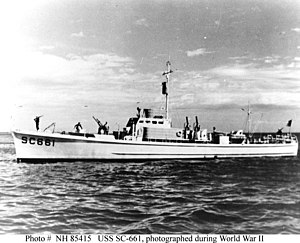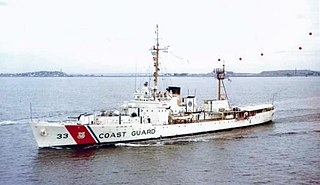
The Treasury-class cutter was a group of seven high endurance cutters launched by the United States Coast Guard between 1936 and 1937. The class were called the "Treasury class" because they were each named for former Secretaries of the Treasury. These ships were also collectively known as the "327's" as they were all 327 feet (100 m) in length. The Treasury-class cutters proved highly adaptable, dependable, versatile and long-lived warships. Most served the United States for over 40 years, including with distinction and heroism through World War II, Korea, and Vietnam.
USS SC-1329 was an SC-497-class submarine chaser in the United States Navy.
The history of the United States Coast Guard goes back to the United States Revenue Cutter Service, which was founded on 4 August 1790 as part of the Department of the Treasury. The Revenue Cutter Service and the United States Life-Saving Service were merged to become the Coast Guard per 14 U.S.C. § 1 which states: "The Coast Guard as established January 28, 1915, shall be a military service and a branch of the armed forces of the United States at all times." In 1939, the United States Lighthouse Service was merged into the Coast Guard. The Coast Guard itself was moved to the Department of Transportation in 1967, and on 1 March 2003 it became part of the Department of Homeland Security. However, under 14 U.S.C. § 3 as amended by section 211 of the Coast Guard and Maritime Transportation Act of 2006, upon the declaration of war and when Congress so directs in the declaration, or when the President directs, the Coast Guard operates as a service in the Department of the Navy.
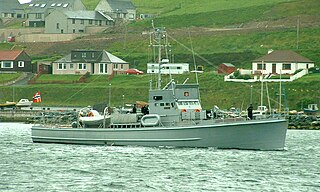
HNoMS Hitra is a Royal Norwegian Navy submarine chaser that saw action during World War II. She is named after the Norwegian island of Hitra.

The Charleston metropolitan area is an urban area centered around Charleston, South Carolina. The U.S. Office of Management and Budget designates the area as the Charleston–North Charleston, SC Metropolitan Statistical Area, a metropolitan statistical area used for statistical purposes only by the United States Census Bureau and other federal agencies. The OMB defines the area as comprising Berkeley, Charleston and Dorchester counties, an area with 799,636 residents in the 2020 census. Principal cities include Charleston, North Charleston, and Summerville. The area is commonly referred to as the Tri-County Area or the Lowcountry, though the latter term has historically referred to South Carolina's southern coast in general.
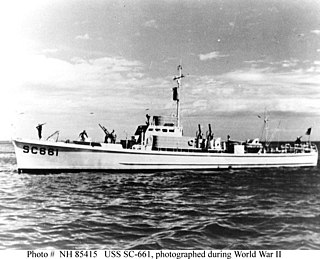
USS SC-499 was a SC-497 class submarine chaser that served in the United States Navy and later the United States Coast Guard during World War II. She was laid down as SC-499 on 24 February 1941 by the Fisher Boat Works in Detroit, Michigan, and launched on 24 October 1941. She was commissioned as USS SC-499 on 18 March 1942. She was later transferred to the Coast Guard on 20 August 1945. Her exact fate is unknown.

USS SC-500 was a United States Navy SC-497-class submarine chaser in commission from 1942 to 1945 during World War II. She later served in the Soviet Navy as BO-319.

USS Might (PG-94) was laid down as Canadian corvette CN-312 by Morton Engineering and Drydock Co., Ltd., Quebec, Canada, on 28 November 1941 and launched as HMS Musk on 15 July 1942. The ship was transferred to the United States Navy on 20 July 1942, renamed Might on 14 August 1942, and commissioned at Quebec on 22 December 1942, Lieutenant Commander J. K. Hartley in command.
USCGC Clover WAGL/WLB/WMEC-292, a Cactus (A) Class buoy tender was built by Marine Iron and Shipbuilding, Duluth, Minnesota. Her keel was laid 3 December 1941, and she was launched 25 April 1942. She was commissioned on 8 November 1942 in the United States Coast Guard as the United States Coast Guard Cutter Clover. She was built as a WAGL, redesignated a WLB in 1965, and again redesignated a WMEC in 1979.
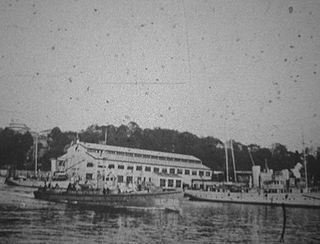
USS SC-22, during her service life known as USS Submarine Chaser No. 22 or USS S.C. 22, was an SC-1-class submarine chaser built for the United States Navy during World War I. She later served in the United States Coast Guard as USCGC Quigley.
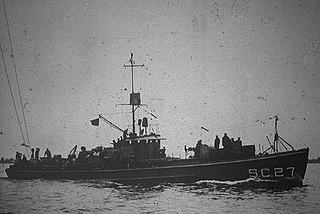
USS SC-27, during her service life known as USS Submarine Chaser No. 27 or USS S.C. 27, was an SC-1-class submarine chaser built for the United States Navy during World War I. She later served in the United States Coast Guard as USCGC Richards.
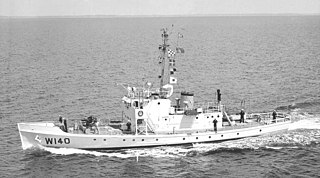
The Active-class patrol boat was one of the most useful and long-lasting classes of United States Coast Guard cutters. Of the 35 built in the 1920s, 16 were still in service during the 1960s. The last to be decommissioned from active service was the Morris in 1970; the last in actual service was the Cuyahoga, which sank after an accidental collision in 1978.

USCGC Anacapa (WPB-1335) is an Island-class cutter of the United States Coast Guard. She is based at Petersburg, Alaska and is responsible for law enforcement, search and rescue, and maritime defense.

USCGC Hamilton (WMSL-753) is the fourth Legend-class cutter, also known as the National Security Cutter (NSC), of the United States Coast Guard. She is the fifth cutter named after Alexander Hamilton, who was the first United States Secretary of the Treasury and in that position requested the formation of the United States Coast Guard. The cutter's sponsor is Linda Kapral Papp, the wife of Coast Guard Commandant Robert J. Papp, Jr.

Joint Base Charleston is a United States military facility located partly in the City of North Charleston, South Carolina and partly in the City of Goose Creek, South Carolina. The facility is under the jurisdiction of the United States Air Force 628th Air Base Wing, Air Mobility Command (AMC).

USCGC McLane (WSC-146) was a 125 ft (38 m) United States Coast Guard Active-class patrol boat in commission from 1927 to 1971. She was named for Louis McLane, (1786–1857) who was appointed in 1833 as United States Secretary of State. In May 1966, she was redesignated as (WMEC-146).

Fellows & Stewart Inc. was a shipbuilding company in San Pedro, California on Terminal Island's Pier 206. To support the World War II demand for ships Fellows & Stewart built Crash rescue boats and submarine chasers. The Crash rescue boats were operated by both the US Navy and US Army during the war. Some crash rescue boat also served in the Korean War. Fellows & Stewart was founded as Joe Fellows Boat Shop in 1896. Joe Fellows was an English immigrant who learned boat building in Seattle and San Francisco. The company changed to Fellows & Stewart as the shipyard manager, Victor Stewart joined in as a partner. Many of the boats were designed by Joseph Pugh. From 1907 to 1917 called the Joe Fellows Yacht and Launch Company. In the 1910s, 1920s and 1930s the shipyard built many yachts and sailboats. The name changed to the Fellows & Stewart Inc. in 1917. In 1967 the shipyard was sold to Harbor Boatbuilding. The shipyard is sometimes listed as being in Wilmington. The records of Fellows & Stewart are housed at the Los Angeles Maritime Museum. Notable boats and ships: HMAS Air View, USS SC-1012, Rudolph Valentino's 1926 yacht Charade (Phoenix) and the Ranger built in 1917 active at the Santa Barbara Maritime Museum.

Victory Shipbuilding was a shipbuilding company in Newport Beach, California. To support the World War 2 demand for ships Victory Shipbuilding built: Tugboats and two sub chasers. Victory Shipbuilding opened in 1943. After World War 2, the shipyard closed. The shipyard was located at 613 Pacific Coast Hwy, Newport Beach. This was one of the few shipyards not on the waterfront.

Al Larson Boat Shop or Al Larson Boat Building is a shipbuilding and dry dock repair company in San Pedro, California on Terminal Island. To support the World War 2 demand for ships Al Larson Boat Shop built: US Navy Sub chasers and Minesweepers. Al Larson Boat Shop was started in 1903 by Peter Adolph (Al) Larson, a Swedish immigrant. Larson started by building boats by hand from Pacific Northwest lumber. As the shop grew, he moved to its current location in Fish Harbor, in the Port of Los Angeles. Adolph Larson's son sold the boat shop in 1960 to Andy and Gloria Wall. The shop was small at this time with only five employees. The Wall family is still running the shipyard in the Port of Los Angeles. The shipyard is the only one in the Port of Los Angeles now operating and able to work on ships of all sizes with its 100 employees. The shipyard is at 1046 South Seaside Ave, Terminal Island, with 2.35 acres of land and 5.35 acres of waterways. The shipyard also runs a marina, Al Larson Marina.
